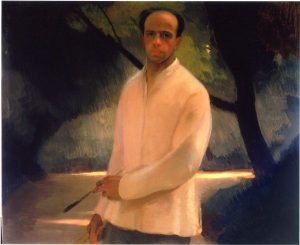Biography

BOCCHI Amedeo, painter and occasionally sculptor (Parma 1883 – Rome 1976). Third of seven brothers, he is enrolled by his father Federico, who is a decorator, at the Royal Institute of Fine Arts in Parma with the intention of starting him as a professional. Here he is immediately noticed by Cecrope Barilli, then famous painter, who sensing the early qualities of the boy directs him to the painting course. Among his fellow students he makes two encounters that indelibly mark the course of his life: Rita Boraschi, who becomes his wife in 1906, dying immediately after the birth of his beloved daughter Bianca (1908) and Renato Brozzi, sculptor and engraver who he will be the brotherly friend of all life.
The first Roman stay dates back to 1902. He had been sent by his master to attend the three-year free school of the nude at the Academy of Fine Arts. Here he came into contact with the artistic environment of the capital, still dominated by the charismatic figure of Nino Costa and the group of refined symbolists (Sartorio , De Carolis and Cellini) sponsored by Vate Gabriele D’Annunzio, heir to that aesthetic taste that had already been disclosed by Nino Costa after his overseas stays.
An instinctive sympathy then binds him to the XXV Group of the Roman countryside, behind whose footprints he discovers the poignant landscapes of the Pontine marshes.
There are therefore three fundamental components of his painting: a primitive human and social charge, drawn from the solid roots of his Emilian blood (see Baptism and Abbrutimento, both from 1905, and Revolt from 1906); a Corottian taste for the landscape en plein air, reinforced by the knowledge of the “XXV” and finally the love for the stylistic elements of subtle symbolism, already all Liberty in the use of sinuous lines, as can be seen in the Lotus Flowers of 1905.
Moreover, Bocchi isolates himself almost immediately from any artistic association and movement. Interested in all the technical forms of painting, we find him in 1910 in Padua following the painter A. Casanova in the execution of a cycle of frescoes in the Basilica del Santo.
In 1911 he met Klimt at the great Rome Exhibition, being fascinated by the refinement of the mosaic technique. The discovery of Terracina dates back to the same year, which, with its marshes and the harsh life of the countryside, together with Villa Strohl-Fern, will constitute one of the fundamental themes of its production, as well as an ideal place for summer holidays. Between 1912 and 16, the painter took the path of liberty two-dimensionality, however traveled in an entirely original way compared to Klimt, “putting – as Roberto Tassi says – nerves and bones to the style of the Austrian painter”. We thus have a whole series of masterpieces (Portrait of a lady with a black hat, triptych of the Three Sisters etc.) up to the top with the fundamental cycle of frescoes for the board room of the Cassa di Risparmio di Parma, where it does not limit his work on wall paintings that enhance the banking function (Savings, Protection and Wealth are the themes of the three walls) but pervades the whole environment of a suffused secessionist atmosphere. He takes care of everything, from the architectural structure of the room to the panels that cover the walls, designs the furniture and the carpet and designs a large skylight chandelier with suns engraved in brightly colored glass.
At the outbreak of the First World War (1915), he settled permanently in Rome with his great friend Brozzi. The patron Alfred Strohl-Fern had granted two of the ateliers scattered in his large park to his inseparable friends, where they will spend the rest of their long life.
In Villa Strohl-Fern Amedeo comes into contact with the best of 20th century Roman painting (from Spadini to De Chirico, from Socrates to Trombadori, from Moggioli to Guidi, from Bertoletti to Oppo, and then the sculptors Selva, D’Antino, Drei , Torresini, Martini etc. etc.). Bocchi, while studying everything, remains one block. He silently elaborates a very personal, two-dimensional and almost fauves style, for his great portraits that from 1917 to 1934 mark the daily hours of life among family affections. Thus were born the great masterpieces: In the park, In the lawn, Morning breakfast, Summer afternoon, Backlight, The convalescent, Annunciation etc. : The first three plus, After the bath and Girl reading, are exhibited at the Venice Biennale in 1920, forcing Bocchi to criticize as one of the most talented Italian painters of the moment. Almost all the paintings deal with his daughter Bianca or Nicolina, the beautiful model of Anticoli Corrado who in 1919 became his second wife.
Between 1920 and 1930 he participated in all the Venice Biennials, at the Pesaro Gallery Exhibition in Milan in 21st, at the Roman Biennial in 23rd and in an impressive series of European and American exhibitions. In 1925 he was appointed Academician of San Luca, of which he later became Vice President (1935).
The tragic death of Nicolina (1923) first and of her beloved daughter Bianca (1934) then practically put an end to Bocchi’s public career which survives for another forty-two years, closed in the garden of Villa Strohl-Fern in the company of many memories.
The spotlight only rekindled on him in 1966, when the critic Fortunato Bellonzi accidentally rediscovered Nel Parco, painted in 1919. From this moment it is all a crackle of initiatives culminating with the public ceremony in Parma in 1973, during which the mayor, after reading the telegram of the President of the Republic that gives Bocchi the Commenda, he gives him the gold medal for cultural and artistic merits of the Minister of Education.
He died in his Villa in Rome in 1976.